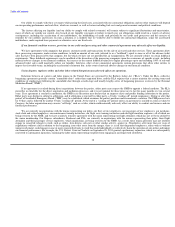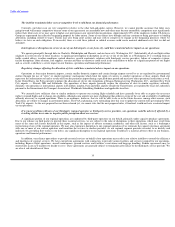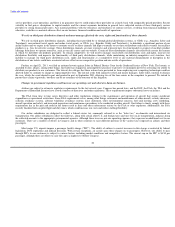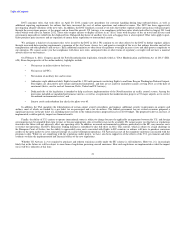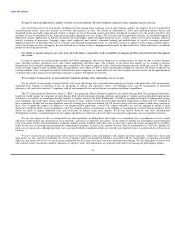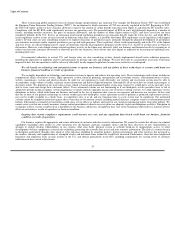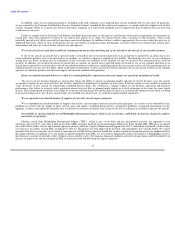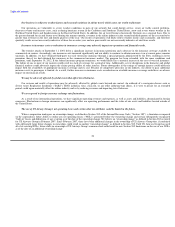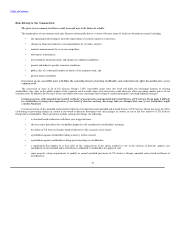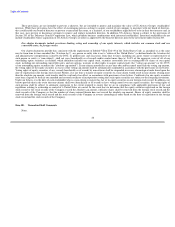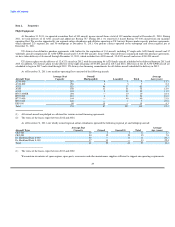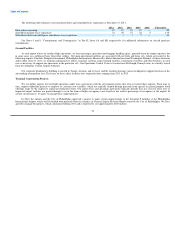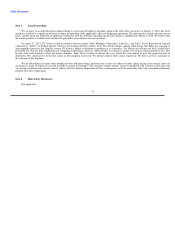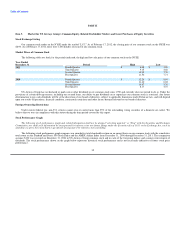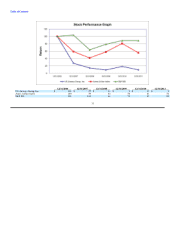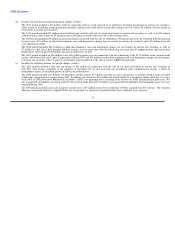US Airways 2011 Annual Report Download - page 29
Download and view the complete annual report
Please find page 29 of the 2011 US Airways annual report below. You can navigate through the pages in the report by either clicking on the pages listed below, or by using the keyword search tool below to find specific information within the annual report.
Table of Contents
Our business is subject to weather factors and seasonal variations in airline travel, which cause our results to fluctuate.
Our operations are vulnerable to severe weather conditions in parts of our network that could disrupt service, create air traffic control problems,
decrease revenue and increase costs, such as during hurricane season in the Caribbean and Southeast United States, snow and severe winter weather in the
Northeast United States and thunderstorms in the Eastern United States. In addition, the air travel business historically fluctuates on a seasonal basis. Due to
the greater demand for air and leisure travel during the summer months, revenues in the airline industry in the second and third quarters of the year tend to be
greater than revenues in the first and fourth quarters of the year. Our results of operations will likely reflect weather factors and seasonality, and therefore
quarterly results are not necessarily indicative of those for an entire year, and our prior results are not necessarily indicative of our future results.
Increases in insurance costs or reductions in insurance coverage may adversely impact our operations and financial results.
The terrorist attacks of September 11, 2001 led to a significant increase in insurance premiums and a decrease in the insurance coverage available to
commercial air carriers. Accordingly, our insurance costs increased significantly and our ability to continue to obtain insurance even at current prices remains
uncertain. In addition, we have obtained third-party war risk (terrorism) insurance through a special program administered by the FAA, resulting in lower
premiums than if we had obtained this insurance in the commercial insurance market. The program has been extended, with the same conditions and
premiums, until September 30, 2012. If the federal insurance program terminates, we would likely face a material increase in the cost of war risk insurance.
The failure of one or more of our insurers could result in a lack of coverage for a period of time. Additionally, severe disruptions in the domestic and global
financial markets could adversely impact the claims paying ability of some insurers. Future downgrades in the ratings of enough insurers could adversely
impact both the availability of appropriate insurance coverage and its cost. Because of competitive pressures in our industry, our ability to pass additional
insurance costs to passengers is limited. As a result, further increases in insurance costs or reductions in available insurance coverage could have an adverse
impact on our financial results.
We may be adversely affected by global events that affect travel behavior.
Our revenue and results of operations may be adversely affected by global events beyond our control. An outbreak of a contagious disease such as
Severe Acute Respiratory Syndrome ("SARS"), H1N1 influenza virus, avian flu, or any other influenza-type illness, if it were to persist for an extended
period, could again materially affect the airline industry and us by reducing revenues and impacting travel behavior.
We are exposed to foreign currency exchange rate fluctuations.
As a result of our international operations, we have significant operating revenues and expenses, as well as assets and liabilities, denominated in foreign
currencies. Fluctuations in foreign currencies can significantly affect our operating performance and the value of our assets and liabilities located outside of
the United States.
The use of US Airways Group's net operating losses and certain other tax attributes could be limited in the future.
When a corporation undergoes an ownership change, as defined in Section 382 of the Internal Revenue Code ("Section 382"), a limitation is imposed
on the corporation's future ability to utilize any net operating losses ("NOLs") generated before the ownership change and certain subsequently recognized
"built-in" losses and deductions, if any, existing as of the date of the ownership change. We believe an "ownership change" as defined in Section 382 occurred
for US Airways Group in February 2007. Since February 2007, there have been additional changes in the ownership of US Airways Group that, if combined
with sufficiently large future changes in ownership, could result in another "ownership change" as defined in Section 382. Until US Airways Group has used
all of its existing NOLs, future shifts in ownership of US Airways Group's common stock could result in new Section 382 limitations on the use of our NOLs
as of the date of an additional ownership change.
26




